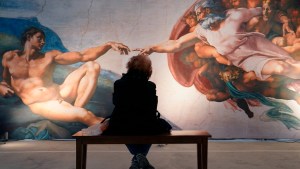Located in Chelsea, on the west side of New York City, the Luhring Augustine art gallery is hosting a new exhibition that focuses on the medieval concept of the human form. Titled “The Medieval Body,” the display, which features numerous medieval Christian works of art, will be open from January 21 until March 12, 2022.
‘The Medieval Body’
The exhibition focuses on the medieval concept of the body’s interconnection with the soul. It is meant to tell a unique story about the human form as both a physical entity and a recognizable metaphor. The presented works span the course of a millennium in order to offer insight into the body’s influence on the development of European art of the Middle Ages.
The Luhring Augustine website explains:
“The title of the exhibition refers to both a literal thread of figuration that runs throughout the works in the presentation, as well as the complex and often shifting symbolism of the human body in the medieval period. For thinkers and artists of that time, the human body served as a rich source of religious and philosophical significance, one that was in a constant state of flux between idealism and disfigurement.”
The body in art
Depictions of the human form evolved considerably during the medieval era. In the early Middle Ages, artists tended to shy away from focusing on human suffering, but that changed over time. Crucifixes and depictions of the martyrdom of saints became highly prized objects of veneration, especially in churches.
One of the prized pieces of the collection is The Martyrdom of Saint Sebastian by Jörg Lederer. This statue was sculpted in fantastic detail to show the wounds St. Sebastian sustained during his martyrdom. A close inspection of the holes in his chest shows what remains of the wood from broken arrows that pierced the statue’s body. The work is made all the more breathtaking, and chilling, by the exactness of the anatomical modeling.
Curator Sam Fogg wrote of the exhibition on his website:
“The Martyrdom of Saint Sebastian by Jörg Lederer gives prominence to the late medieval trend of displaying a suffering human body at the altar, while the Man of Sorrows by the Master of the Holy Kinship communicates the duality of the self, representing a body both dead and alive, human and God. Spanning a period of a thousand years, these works bring us much closer to an understanding that the body in medieval art always had a purpose, despite our own assumptions about its profanity or sanctity.”
The exhibition, “The Medieval Body,” will remain open until March 12, which means it will be open for the first week of Lent. Visit Luhring Augustine to learn the details and book a viewing today.
Too far from New York? Click here to view individual images of the exhibition’s many medieval Christian artworks.

